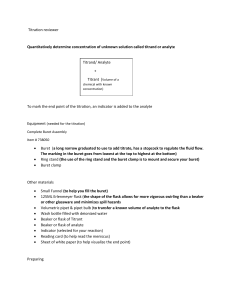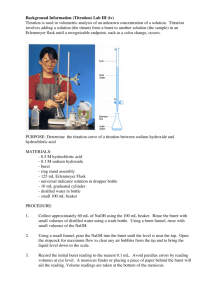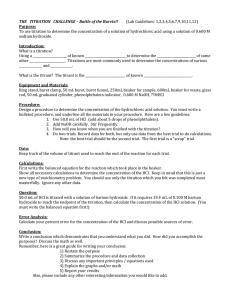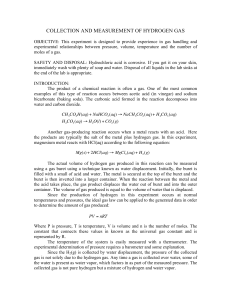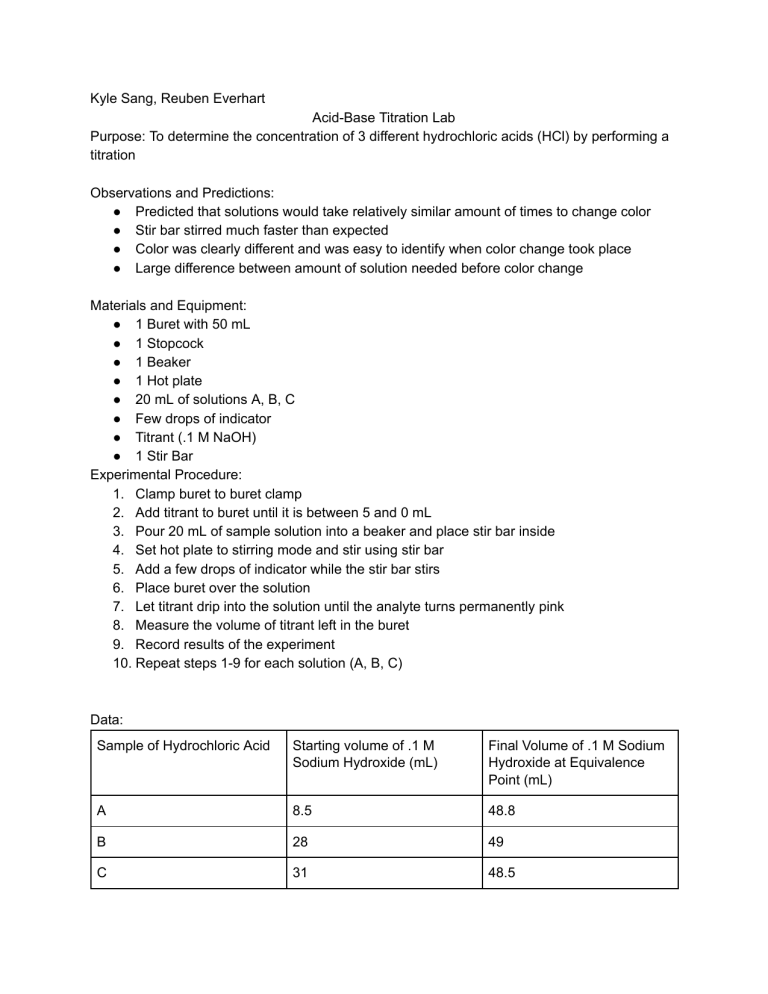
Kyle Sang, Reuben Everhart Acid-Base Titration Lab Purpose: To determine the concentration of 3 different hydrochloric acids (HCl) by performing a titration Observations and Predictions: ● Predicted that solutions would take relatively similar amount of times to change color ● Stir bar stirred much faster than expected ● Color was clearly different and was easy to identify when color change took place ● Large difference between amount of solution needed before color change Materials and Equipment: ● 1 Buret with 50 mL ● 1 Stopcock ● 1 Beaker ● 1 Hot plate ● 20 mL of solutions A, B, C ● Few drops of indicator ● Titrant (.1 M NaOH) ● 1 Stir Bar Experimental Procedure: 1. Clamp buret to buret clamp 2. Add titrant to buret until it is between 5 and 0 mL 3. Pour 20 mL of sample solution into a beaker and place stir bar inside 4. Set hot plate to stirring mode and stir using stir bar 5. Add a few drops of indicator while the stir bar stirs 6. Place buret over the solution 7. Let titrant drip into the solution until the analyte turns permanently pink 8. Measure the volume of titrant left in the buret 9. Record results of the experiment 10. Repeat steps 1-9 for each solution (A, B, C) Data: Sample of Hydrochloric Acid Starting volume of .1 M Sodium Hydroxide (mL) Final Volume of .1 M Sodium Hydroxide at Equivalence Point (mL) A 8.5 48.8 B 28 49 C 31 48.5 Data Analysis: 1. NCl + NaOH => NaCl + H2O Nitrogen Chloride + Sodium Oxide => Sodium Chloride + Water 2. Solution A: 48.8mL - 8.5mL = 40.3mL Solution B: 49mL - 28mL = 21mL Solution C: 48.5mL - 31mL = 17.5mL 3. Solution A: Ma x 20 mL = 0.1 M x 40.3 mL = 0.2015 M Solution B: Ma x 20 mL = 0.1 M x 21 mL = 0.105 M Solution C: Ma x 20 mL = 0.1 M x 17.5 mL = 0.0875 M Error Analysis: Sample Our Values(M) True Values(M) Percent Error(%) A .2015 .2 .75 B .099 .1 1 C .05 .05 0 Our errors were caused by natural margin of error, as well as the setup of the lab and human error. The setup of the lab required us to stop the solution being dripped once we saw color, however do to the nature of the lab and human error it made it impossible to have an exact stopping point. We got lucky with Sample C, but that error mostly accounts for the other small differences. Conclusion: We determined our values for each sample by finding how much needed to be dripped into each solution before it could get a color change. For solution A we got .2015 M, for solution B we got .105 M, and for Solution C we got .0875 M. These were all very close to the true values, with solution C’s even being exactly correct. The percent errors were .75% for A, 1% for B, and perfect for C. These can be explained by simple human error, the fact that it relied on us to stop the experiment at the exact correct time.


